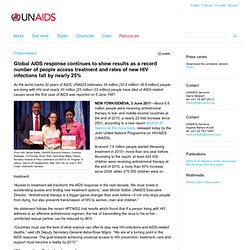

2012. 2011 & 2010. AIDS. Human immunodeficiency virus infection / acquired immunodeficiency syndrome (HIV/AIDS) is a disease of the human immune system caused by infection with human immunodeficiency virus (HIV).[1] During the initial infection, a person may experience a brief period of influenza-like illness.

This is typically followed by a prolonged period without symptoms. As the illness progresses, it interferes more and more with the immune system, making the person much more likely to get infections, including opportunistic infections and tumors that do not usually affect people who have working immune systems. HIV/AIDS has had a great impact on society, both as an illness and as a source of discrimination.
The disease also has significant economic impacts. There are many misconceptions about HIV/AIDS such as the belief that it can be transmitted by casual non-sexual contact. Global AIDS response continues to show results as a record number of people access treatment and rates of new HIV infections fall by nearly 25% Global AIDS response continues to show results as a record number of people access treatment and rates of new HIV infections fall by nearly 25% As the world marks 30 years of AIDS, UNAIDS estimates 34 million [30.9 million–36.9 million] people are living with HIV and nearly 30 million [25 million–33 million] people have died of AIDS-related causes since the first case of AIDS was reported on 5 June 1981 (From left): Michel Sidibé, UNAIDS Executive Director; Christina Rodriguez, Co-Founder, Smart Youth; Asha-Rose Migiro, Deputy Secretary-General at Press conference on AIDS at 30: Progress of nations, held at UN Headquarters, New York City on June 3, 2011.Credit: UNAIDS/B.

Hamilton. HIV Infection Rate Fell 25% Over the Last Decade.